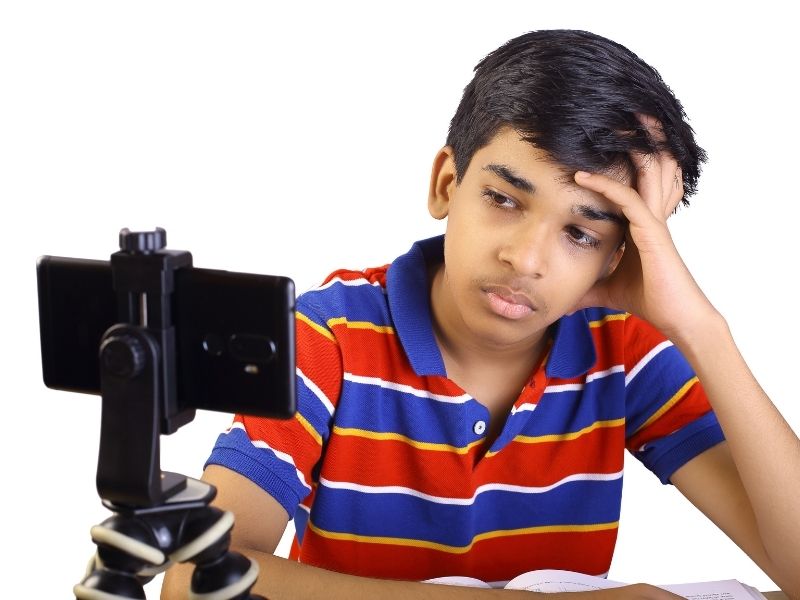– Sukanya Nandy
There’s a good side to online classes and a bad side too. Schools that are able to provide engaging online classes along with co-scholastic activities and regular peer-to-peer interaction have seen better mental health among students. For others, it has become monotonous, which has led to a rise in anxiety and hyperactivity among children. In this regard, EducationWorld spoke with a few child experts to know why they think this is happening and how it can be addressed.
 Dr Kannan Gireesh, psychiatrist, psychotherapist and founder, Live Life Education says, “What they are lacking is peer-to-peer learning. Social learning is not happening as they do not have friends to talk to and build new friendships. Building friendships is very important especially in the lower age groups, which gives them security and self-esteem that gives them a sense of belonging.”
Dr Kannan Gireesh, psychiatrist, psychotherapist and founder, Live Life Education says, “What they are lacking is peer-to-peer learning. Social learning is not happening as they do not have friends to talk to and build new friendships. Building friendships is very important especially in the lower age groups, which gives them security and self-esteem that gives them a sense of belonging.”
“Many children have become bored with online classes. In certain schools, online classes are very monotonous. Hence, what these students are doing is switching off the camera and are doing other activities. It’s like a time pass for them. Not only mental health, but they are also facing some health problems like eye strain, headaches and fatigue from seeing the screen for such a long time. Besides, sports education and extracurricular classes have also stopped. As most of the parents are working and the child is all alone in the house, there is no way the children can interact with anyone,” he adds.
 UK-based internationally recognised parenting expert, broadcaster, speaker and author of Parenting Made Easy — How to Raise Happy Children (2012) Sue Atkins explained, “With the sudden halt to in-person learning, many students have missed their friends, yearned to be out of the house, developed erratic sleep habits and drove their (often working) parents crazy. On top of that, many were dealing with the trauma of a sick or dying family member, economic hardship and major changes to the life they once had.
UK-based internationally recognised parenting expert, broadcaster, speaker and author of Parenting Made Easy — How to Raise Happy Children (2012) Sue Atkins explained, “With the sudden halt to in-person learning, many students have missed their friends, yearned to be out of the house, developed erratic sleep habits and drove their (often working) parents crazy. On top of that, many were dealing with the trauma of a sick or dying family member, economic hardship and major changes to the life they once had.
As the pandemic drags on, it’s clear that not all kids are alright. According to a survey by Gallup, nearly 3 in 10 parents said their child is experiencing emotional or mental anxiety because of social distancing and school closures.”
“Schools should think about using the virtual learning environment to create a new relationship between teachers and children, not just one where kids can get help with maths, but where children are talking to teachers about what’s going on & the focus is on their well-being & mental health.
Parents can support their children by actively listening, creating new routines that create a feeling of predictability in an uncertain world and nurturing self-esteem and self-care by playing, talking and eating with them. Collaboration between schools, families, community leaders and health officials will be even more critical to support children’s needs in and out of school as the world grapples with controlling the virus,” Atkins adds.
 “As educational practitioners, we are committed to the wholesome development of the child and as we know, learning is not only about book knowledge, but also the physical, emotional, social and mental wellbeing of the child,” says Prema Muralidhar, principal of Ajman-based Woodlem Park School.
“As educational practitioners, we are committed to the wholesome development of the child and as we know, learning is not only about book knowledge, but also the physical, emotional, social and mental wellbeing of the child,” says Prema Muralidhar, principal of Ajman-based Woodlem Park School.
She adds, “As such, to help mitigate the effects of being endlessly homebound, at WPS we integrated more holistic approaches and more activity-based learning during our virtual sessions to help break the monotony and to keep the students engaged. Our students were introduced to breakout rooms that consist of smaller groups of students and provide the opportunity for them to interact briefly or to brainstorm with their peers during classes.
Incorporating regular PE and Karate sessions have helped to break the sedentary lifestyle and to encourage exercise. Our wellness programme is equally conducted for half an hour, twice a week where students practice breathing exercises, talk about anything of interest outside the normal curriculum, and share their thoughts and talents. The STTT (student-teacher talking time) also presents a brief interlude at the beginning of the day when the teacher can have a chat with the students to find out how they are generally doing.”
Also read:
Covid-19-related health anxiety in children
Queries on mental health of kids triple during lockdown
World Mental Health Day: Impact of the pandemic on teachers
Posted in International, News



























